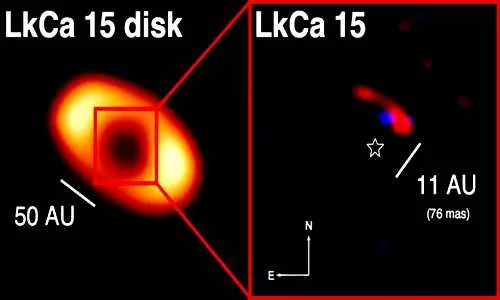In an incredible breakthrough, astronomers have captured the first direct image of a planet forming around its star. Using the powerful 10-meter Keck telescopes in Hawaii, scientists managed to observe a young protoplanet named LkCa 15 b, still in the process of being built from the surrounding dust and gas. This groundbreaking discovery sheds light on how planets and solar systems come to be, offering a glimpse into the earliest stages of planetary development.
The Discovery of LkCa 15 b: A Rare Glimpse into Planetary Formation
LkCa 15 b is a gas giant located around 450 light-years from Earth, orbiting its young parent star in the constellation Taurus. What makes this discovery remarkable is that LkCa 15 b is still in its formative stages. It sits inside a large gap in a disk of cooler dust and gas surrounding the star, slowly accumulating matter as it grows. This planet is the youngest ever detected, at approximately five times younger than the previous record holder.

Adam Kraus, an astronomer at the University of Hawaii’s Institute for Astronomy, explained the significance of this discovery: “LkCa 15 b is being built out of the dust and gas surrounding its star. Until now, we couldn’t directly observe this process because it happens so close to the star. But for the first time, we’ve been able to directly measure the planet itself and the material surrounding it.” This insight is crucial for understanding the intricacies of planet formation, a phenomenon that has long been elusive to astronomers.
Innovative Techniques Unlock New Discoveries
The discovery of LkCa 15 b was made possible through a combination of cutting-edge technology and innovative observational techniques. Astronomers used Keck’s Adaptive Optics system, which employs a deformable mirror to correct atmospheric distortions to starlight. This system works in tandem with a method called aperture mask interferometry, a technique that manipulates light waves by placing a mask with several small holes in the path of the light collected by the telescope.
“It’s like using an array of small mirrors,” explained Kraus. “We manipulate the light and cancel out distortions, allowing us to observe features that would otherwise be obscured by the star’s brightness.” This optical sleight of hand enabled the team to block out the overwhelming light from the parent star and resolve the dusty disk surrounding it. Within this disk, they found gaps where protoplanets are forming—a phenomenon that could only be observed with the precision provided by these techniques.
Unraveling the Mysteries of Planetary Birth
The discovery of LkCa 15 b was part of a larger survey of 150 young, dusty stars in star-forming regions. Out of this initial survey, astronomers honed in on a dozen stars for further study, with LkCa 15 quickly standing out. “LkCa 15 was only our second target, and we immediately knew we were seeing something new,” Kraus recalled. The team initially detected a faint point of light near the star, which they suspected might be a planet similar in size to Jupiter. After returning a year later to gather more data, they discovered that the situation was far more complex.
Further observations at different wavelengths revealed that LkCa 15 b is a super Jupiter-sized planet, surrounded by a disk of dust and gas. This discovery suggests that the star system may eventually evolve into a full solar system, with LkCa 15 b as its centerpiece. “We realized we weren’t just seeing a planet,” said Kraus. “We were looking at the birth of what could become an entire solar system.”
A New Era of Astronomy: Keck Observatory’s Role in Planetary Science
The Keck Observatory has long been at the forefront of astronomical research. Its twin 10-meter optical and infrared telescopes, located atop Mauna Kea on the Big Island of Hawaii, are equipped with advanced instruments that allow scientists to peer deep into the universe. These instruments include high-resolution spectrographs, imagers, and integral-field spectroscopy, all of which are critical for observing distant celestial objects.
The observatory’s state-of-the-art laser guide star adaptive optics system is one of the most advanced in the world. This technology compensates for much of the distortion caused by Earth’s atmosphere, allowing for clearer and more detailed observations of space. The Keck telescopes, with their unparalleled capabilities, have been instrumental in pushing the boundaries of planetary science.
Dr. Michael Ireland of Macquarie University and the Australian Astronomical Observatory emphasized the significance of Keck’s contribution: “Interferometry has existed since the 1800s, but it wasn’t until we combined it with adaptive optics that we could begin to observe nearby young stars. Over the last seven years, we’ve been pushing this technique to its limits, using the largest telescopes in the world, including Keck, to explore star-forming regions.”
Looking to the Future: Continued Exploration of LkCa 15 and Beyond
The discovery of LkCa 15 b marks an exciting step forward in the study of planetary formation. Drs. Kraus and Ireland, who co-authored a research paper on the discovery published in The Astrophysical Journal, plan to continue their observations of LkCa 15 and other young stars in star-forming regions. By studying these young systems, they hope to construct a clearer picture of how planets and solar systems develop from clouds of dust and gas.
As technology continues to advance, astronomers are optimistic about uncovering even more secrets of the universe. With powerful observatories like Keck leading the way, our understanding of the cosmos is expanding at an unprecedented rate. Each new discovery brings us closer to answering one of humanity’s most profound questions: How did our own solar system come to be?
Conclusion: A New Window into Planetary Formation
The capture of the first image of a forming planet around its star is a testament to the ingenuity and dedication of modern astronomers. LkCa 15 b offers a rare and invaluable glimpse into the early stages of planetary formation, providing insights that could help unravel the mysteries of how planets—and ultimately solar systems—come into existence.
As Kraus and his team continue their observations, we can expect more groundbreaking discoveries that will deepen our understanding of the universe. In the meantime, the story of LkCa 15 b stands as a reminder of the wonders that await us as we explore the cosmos.

